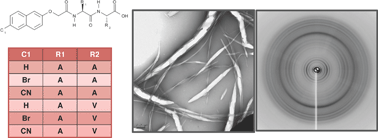Structural determinants in a library of low molecular weight gelators†
Abstract
Low molecular weight hydrogels are formed by molecules that form a matrix that immobilises water to form a self-supporting gel. Such gels have uses as biomaterials such as molecular scaffolds and structures for tissue engineering. One class of low molecular weight gelator (LMWG), naphthalene-conjugated dipeptides, has been shown to form hydrogels via self-assembly following a controlled drop in pH. A library of naphthalene-dipeptides has been generated previously although the relationship between the precursor sequence and the resulting self-assembled structures remained unclear. Here, we have investigated the structural details of a set of dipeptide sequences containing alanine (A) and valine (V) conjugated to naphthalene groups substituted with a Br, CN or H at the 6-position. Electron microscopy, circular dichroism and X-ray fibre diffraction shows that these LMWG may be structurally classified by their composition: the molecular packing is determined by the class of conjugate, whilst the chirality of the self-assemblies can be attributed to the dipeptide sequence. This provides insights into the relationship between the precursor sequence and the macromolecular and molecular structures of the fibres that make up the resulting hydrogels.


 Please wait while we load your content...
Please wait while we load your content...